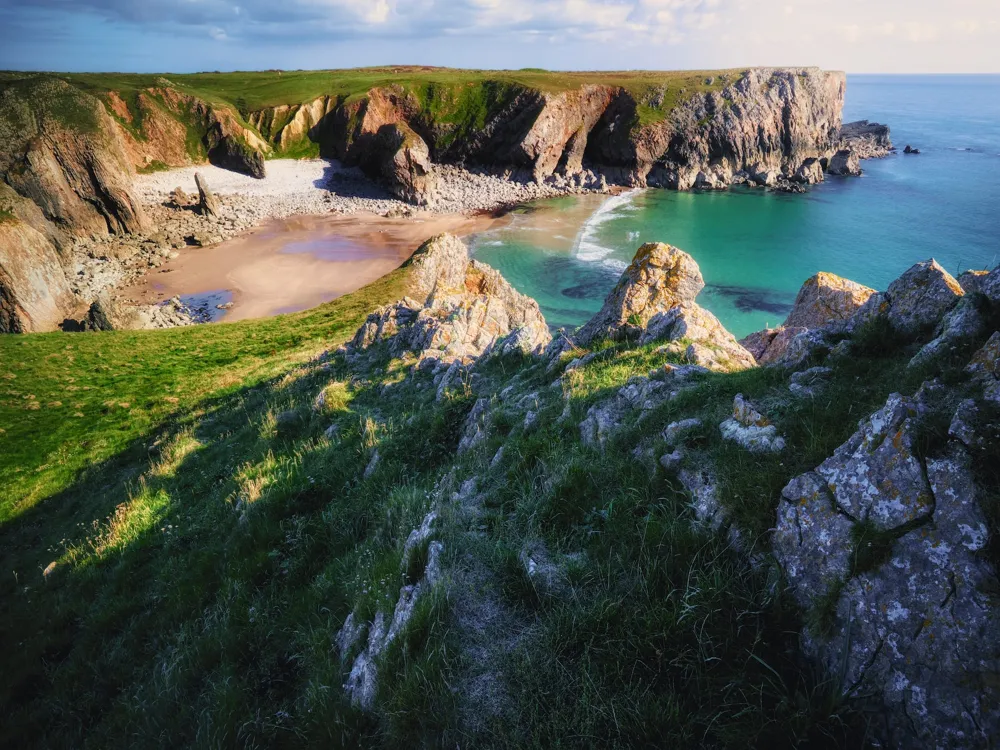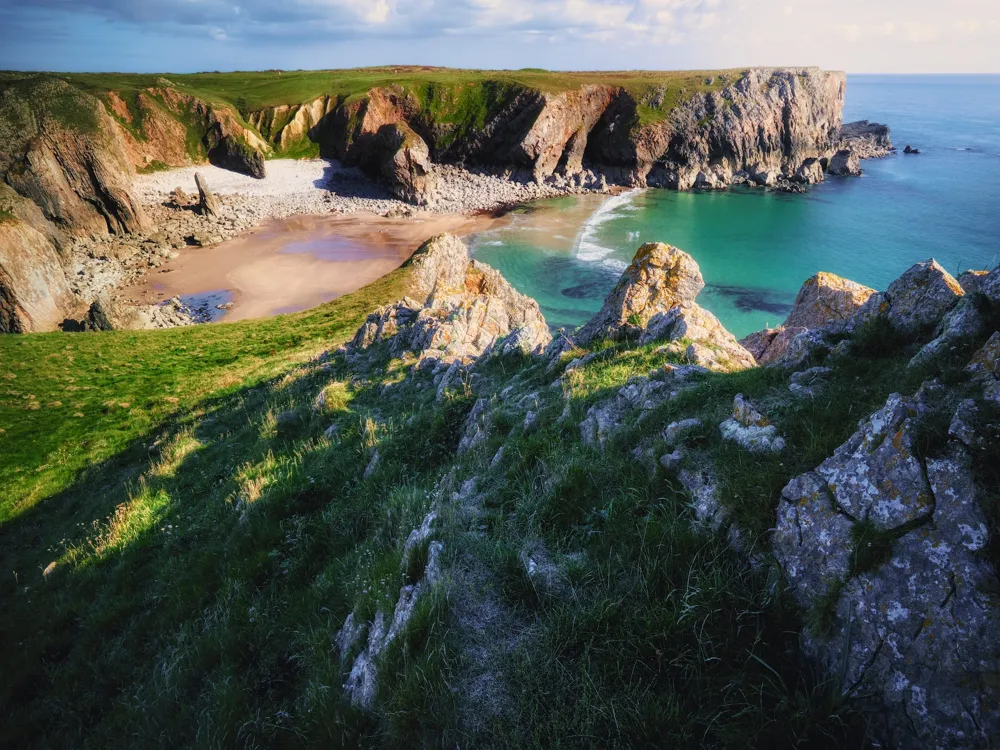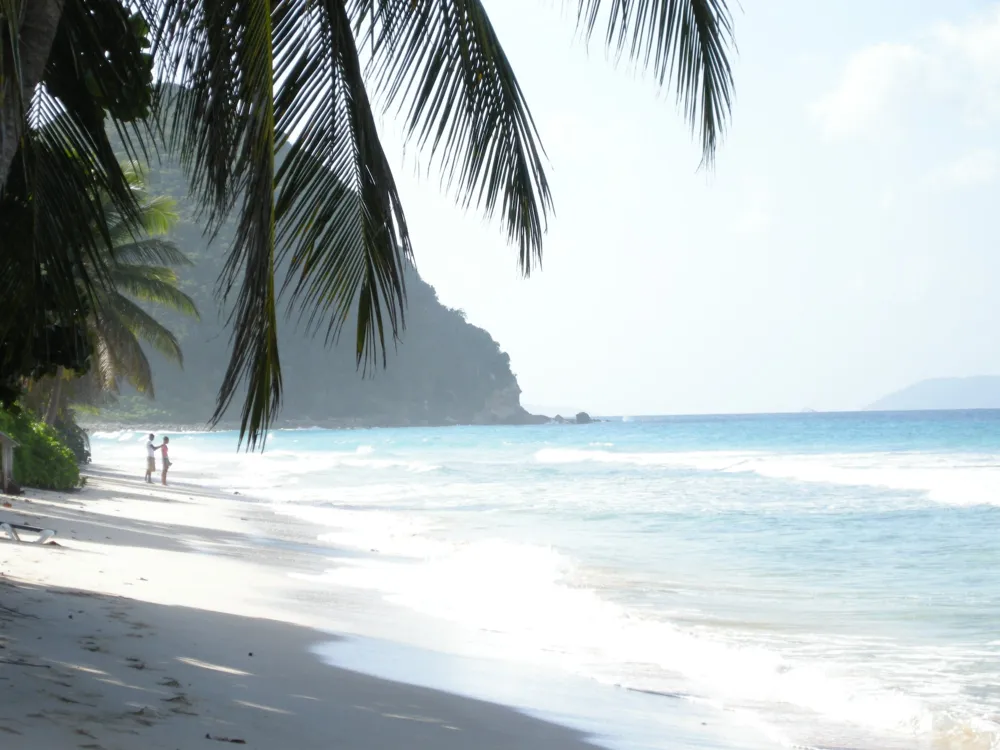Halong Bay, a UNESCO World Heritage Site in northern Vietnam, is a spectacular destination known for its breathtaking natural beauty. This enchanting bay, famous for its emerald waters and thousands of towering limestone islands topped with rainforests, spans an area of around 1,553 square kilometers. Halong Bay's name, which means 'Descending Dragon,' is derived from local legend that dragons descended from heaven to defend Vietnam against invaders, creating the bay's islands in the process. The region's geographical history dates back 500 million years with a diverse range of ecosystems, including coral reefs, freshwater swamp forests, dense mangrove forests, and an array of floral and faunal species. Its dramatic landscapes are the result of millions of years of erosion and weathering, creating unique karst formations. The area is also rich in biodiversity with several endemic species. The bay's cultural and historical importance adds to its allure, with several significant archaeological sites and a rich local folklore. Visitors to Halong Bay are greeted with a magical vista that changes with the time of day and weather, offering an ever-evolving backdrop. The bay is not just a visual spectacle; it's a haven for adventurers and nature lovers alike. From cruising on traditional junks and kayaks, exploring caves and grottoes, to witnessing floating villages and interacting with local fishermen, the bay offers an array of activities that are as diverse as its landscapes. While exploring Halong Bay, one cannot miss the spectacular sight of the limestone pillars. These towering structures, some of which are several hundred meters high, are often shrouded in mist, adding to the mystical feel of the bay. The most famous of these formations is the Fighting Cocks Islet, which is considered a symbol of Halong Bay and appears prominently in local folklore. The bay's beauty extends beneath the surface, with a marine ecosystem that is both complex and fragile. This underwater wonderland is home to a variety of marine species, including fish, mollusks, and crustaceans, many of which are endemic to the area. The biodiversity in Halong Bay is not just limited to its marine life; the surrounding areas are also home to a variety of bird species, making it a popular destination for bird watching. The architecture of Halong Bay is not about man-made structures, but rather the awe-inspiring natural formations that have stood the test of time. The bay is home to an array of limestone karsts and isles in various sizes and shapes. This natural architecture has been sculpted over millions of years by the forces of nature, and each formation has its unique shape and story. The most prominent architectural feature of Halong Bay is its karst limestone formations. These limestone karsts were formed from ancient sediments under intense geological pressure over 20 million years ago. Over time, the relentless forces of wind, rain, and the sea have sculpted these karsts into the breathtaking shapes seen today. Each island, cave, and rock formation tells a story of geological significance and natural beauty. Among these formations, the caves and grottoes of Halong Bay hold particular fascination. The Sung Sot Cave (Surprise Cave), Thien Cung Cave (Heavenly Palace Cave), and Dau Go Cave (Wooden Stakes Cave) are just a few examples of the magnificent caves that can be explored in Halong Bay. These caves are naturally decorated with stalactites and stalagmites in various shapes and sizes, creating an otherworldly experience for visitors. The bay's unique geological history has created not only spectacular surface scenery but also an intricate system of underwater caves. These hidden chambers offer a glimpse into a world few have the chance to see, with their untouched formations and serene waterways. Beyond the natural architecture, the floating villages of Halong Bay represent a fascinating cultural landscape. These communities, built on floating platforms and anchored to the islets, have a unique way of life adapted to the rhythms of the sea. The architecture of these floating homes and markets, made predominantly of wood, is a testament to the resourcefulness and resilience of the local people. The best time to visit Halong Bay is during the spring (March to May) or autumn (September to November) when the weather is pleasant with milder temperatures and clearer skies. Select a cruise that suits your budget and preferences. Options range from luxury cruises offering top-notch facilities to more budget-friendly traditional junks. Bring light and comfortable clothing, swimwear, sun protection, insect repellent, and a good camera to capture the stunning scenery. Be mindful of your environmental impact. Avoid littering and partake in eco-friendly activities to help preserve the bay's natural beauty. Consider visiting nearby attractions such as Cat Ba Island, Lan Ha Bay, or Bai Tu Long Bay for a more comprehensive experience of the region. Halong Bay is accessible from Hanoi, the capital of Vietnam. The most common way to reach Halong Bay is by road, which takes about 3 to 4 hours. Visitors can opt for a bus, shuttle van, or private car from Hanoi to Halong Bay. Another option is to take a seaplane from Hanoi, offering a quicker and more scenic route. For those seeking a more adventurous route, trains from Hanoi to nearby cities and a transfer to Halong Bay are also available.Overview of Halong Bay
Architecture of Halong Bay
Tips When Visiting Halong Bay
Best Time to Visit
Choosing a Cruise
Packing Essentials
Respecting the Environment
Exploring Beyond the Bay
How To Reach Halong Bay
Dau Go Island
Halong Bay
₹ 15,260 onwards
View halong-bay Packages
Halong-bay Travel Packages
View All Packages For Halong-bay
Top Hotel Collections for Halong-bay

Private Pool

Luxury Hotels

5-Star Hotels

Pet Friendly
Top Hotels Near Halong-bay
Other Top Ranking Places In Halong-bay
View All Places To Visit In halong-bay
View halong-bay Packages
Halong-bay Travel Packages
View All Packages For Halong-bay
Top Hotel Collections for Halong-bay

Private Pool

Luxury Hotels

5-Star Hotels

Pet Friendly






















